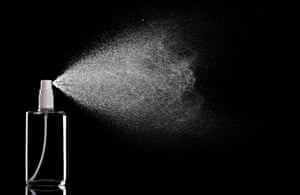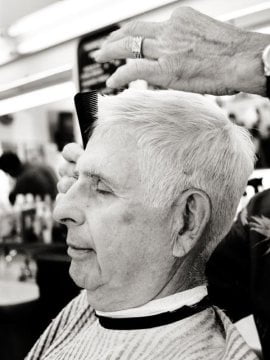
In a corner of the club, Lauren reaches into her bag and plucks out a 30ml, clear plastic spray bottle. It’s the kind you might decant a favourite perfume into, to pack in your carry-on luggage. She points the bottle into her glass of lemonade, pumps twice, swirls it and drinks the mixture in three gulps. Her friend Holli, 23, follows suit. On her phone Lauren sets a timer to count down the next 90 minutes, until the time they’ll take some more. “It takes around 10 minutes to work,” she says, heading back to the bar for a glass of water.
They have just taken G, aka GHB, also known as liquid ecstasy. It can be found in powder form, but more usually an odourless, colourless, slightly salty liquid that prompts a brief, powerful euphoria. When the dosage is wrong, or when it’s mixed with another central nervous system depressant such as alcohol, GHB can put the user into a coma in a matter of minutes, which is why the women aren’t drinking. “I was with two friends who don’t drink alcohol the first time I tried G,” Holli says. “For them, G just made sense – no sugar, no calories and no hangover.”
GHB’s popularity among young women and clubbers in general marks the third stage of its evolution as a drug: first, it was best known as a potent and dangerous date rape drug, slipped into the drinks of unknowing victims. Then it became popular at chemsex parties. Now it’s increasingly popular among young clubbers all over Europe.
According to data given to the Guardian by this year’s Global Drug Survey, out of 1,000 GHB users, one in four women (and one in six men) have overdosed in the last 12 months alone. “That’s a staggering rate of overdose compared with any other recreational substance,” says Adam Winstock, psychiatrist and founder of the survey. “GHB terrifies me as a specialist,” he adds. “It sits in a risk category all of its own, way above other party drugs. The fact that users fall into unrousable states is incredibly dangerous. They’re not only vulnerable to assault, they might stop breathing altogether.”
“The dose thing is tricky,” Holli admits. “We had to work out exactly how much liquid you get per spray. Two sprays is enough for us, some of our guy mates do three.”
The effects from a single dose usually wear off after an hour or so; the women use the timer to avoid re-dosing too early. “We’ve both ‘gone under’ a few times,” Lauren says – they use this term for when they slip into an unrousable sleep, effectively a coma. “But most people do at some point. Usually after you’ve been on it all night and you’re not paying attention to how much you’re taking. It happened to me at a house party a few months ago. I remember I was on the sofa chatting to someone, then the next thing I’m opening my eyes in another room, there’s a coat over me and it’s light outside. My friends had moved me somewhere quiet and kept checking on me. That’s basically it. You roll the person on to their side and let them sleep.” (Winstock agrees that the recovery position is best for someone who has passed out from GHB and that an ambulance should be called if breathing slows to less than eight breaths a minute.)
Gamma-hydroxybutyrate – or GHB – was first synthesised for use as an anaesthetic in the 1960s and has since been used variously as a treatment for narcolepsy and, in the 1980s, as a fat-burner and muscle-builder. By the early 2000s, word that it could induce euphoria had spread and it began to appear more frequently as “liquid ecstasy”. Unlike many other party drugs, GHB can be made in the UK with the right mix of industrial chemicals, and most dealers can be found online.
There are many problems with GHB, but the most pressing for recreational users is that the difference between euphoria and overdose can be a matter of a single millilitre. “Depending on your body weight, 1ml might be enough to have a good time,” says Peter Sheath, from the drugs charity Addaction. He’s based in Liverpool and has been working for two years with men on the chemsex scene, where drugs (mainly GHB, as well as crystal meth) are used at sex parties to enhance the sexual experience and help revellers feel uninhibited. “But go up to 2ml and you could be in accident and emergency in a coma,” Sheath says.
“Now, imagine trying to be that accurate in the context of a night out. You might have taken other substances, it’s dark and G – which is sold as a drain and alloy wheel cleaner – tends to melt plastics, so any measures you’ve got marked on a pipette [how it’s commonly taken] will be gone by the end of the evening.” (Holli and Lauren’s bottle is double thickness, non-melting plastic.)
The drug has been a class C controlled substance in Britain since 2003. It’s difficult to establish how many users there are in this country; it leaves the system within hours, making it difficult to test for, even in the case of a fatality. Sheath believes it’s more widespread than many realise. “I’ve heard about it being used a lot by the student population in Liverpool. They play ‘G roulette’ – everyone is poured a measure [1ml] but one person gets a double dose. They drink it like a shot, then one person ends up overdosing and they’re passed out for the night.”
At the club, the women are talking animatedly about social mobility issues (Holli is training to be a social worker, Lauren is interning for a charity) and the impact of Brexit on their respective home towns. Other than the odd, brief moment when their faces relax into dopey, wide-eyed smiles, they don’t yet seem particularly intoxicated. Neither has played G roulette, but they have heard of similar “party games” – “It’s just kids trying to get fucked up,” Lauren shrugs. Both she and Holli argue that it’s a “safe” drug that fits into their lifestyles. “It’s not like coke where you’re up for days,” Holli says. “You actually feel refreshed when you’ve woken up from a night on G. I’ve gone for a run the next afternoon after being out until 7am. You can even go to the gym on G,” she says. “My ex-boyfriend did.”

[“source=carwale]



















